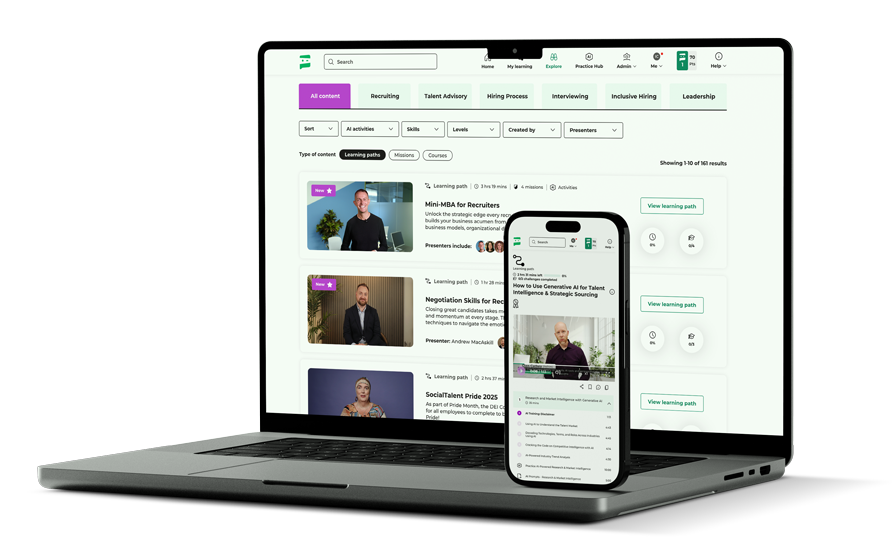
By David Deady
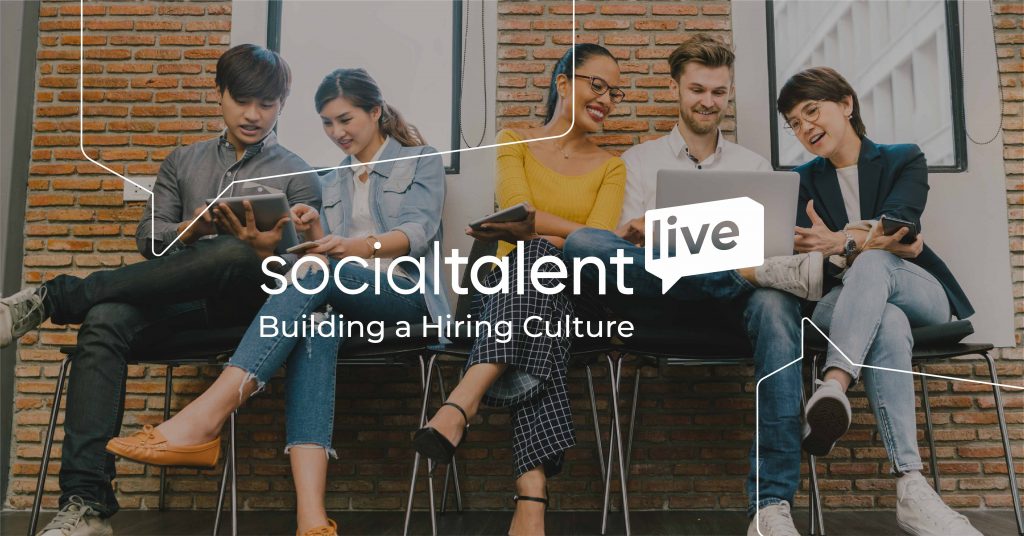
We know that a company’s biggest asset, in terms of success, growth and innovation, is its people. However, when it comes to attracting and hiring the best talent, this is often seen as “someone else’s” responsibility. But hiring is a team sport. It is up to everyone – from leadership and TA to hiring managers and HR – to be engaged, informed and aligned on this front. It should permeate into the DNA of an organization and become shared goal for every stakeholder with the end result being the creation of a culture of hiring.
We recently hosted SocialTalent Live: Building a Hiring Culture, an online leadership event dedicated to the discussion of this vital topic. We brought together TA leaders from global companies such as Cisco, Siemens, PTC and Adidas to discuss what a hiring culture means to them, why it’s vitally important and what are the best methods for embedding this into an organization. Let’s take a look at some of the most striking insights from the event…
Want to watch the full event? Click here.
What is a hiring culture? And why is it important?
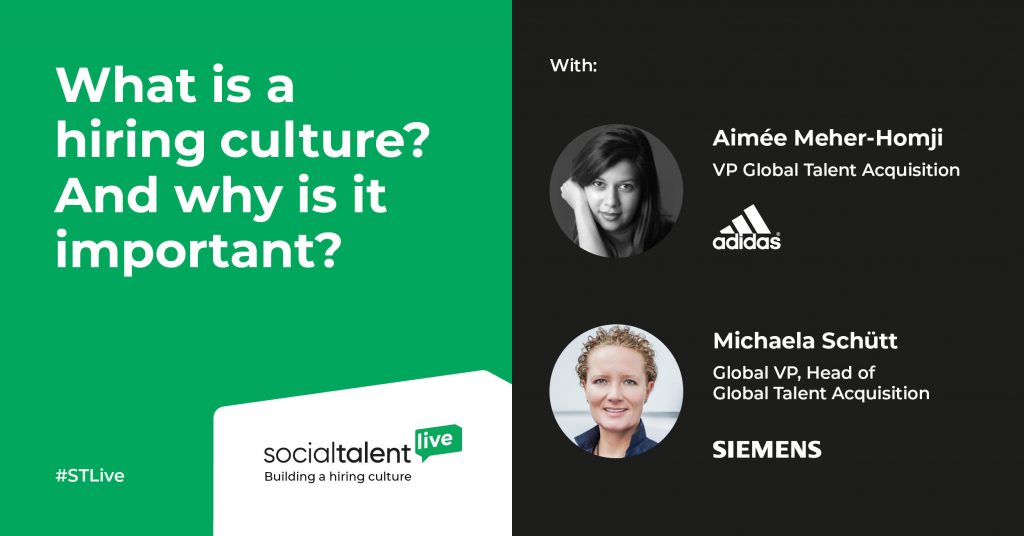
Our first panel dove straight into the heart of defining what a hiring culture is. Aimée kicked us off by emphasizing how it is a mindset that needs to be fostered. And while she recognizes TA’s role in operating hiring as a day-to-day task, it is important for each employee, even those outside the process, to understand that recruiting is everyone’s job. Michaela echoed these sentiments, driving home how crucial hiring managers are in this equation. She said that:
“We in HR may be able to attract talent. But it’s less likely that we will be the ones to select the best candidate to join the company.”
This then brought up the importance of referrals in creating a hiring culture. As Michaela put it: “all employees can be a big source of talent through their personal networks,” they can tell the real story about their work and the company. Aimée correlated this with engagement then, stating that “the focus should be on EVP and retention.” If you don’t have happy employees, they’re not going to refer someone else to the business. Center on employee engagement and the referrals will follow. It’s also imperative to track the number of referrals, specifically from Hiring Managers. This is a great indication of how high a priority recruiting talent is within an organization.
Our recruiter training content can help you find and hire the talent you need.
In terms of how to roll out a hiring culture, Michaela made a very salient point. “There is no perfect checklist…a culture needs to grow.” It’s important to be very clear and transparent in terms of what a hiring culture means in daily work and why the company needs it. And there must be as few hurdles in place to allow people to live and work by this goal. But, as stated by Aimée, “the benefits are manifold.” From boosting DE&I and amplifying your capacity to bringing in top talent and contributing towards business imperatives – “no company can function without a strong people culture.” Bottomline: you exponentially increase your talent pool if you create and operationalize a culture of hiring.
The hiring culture in Cisco
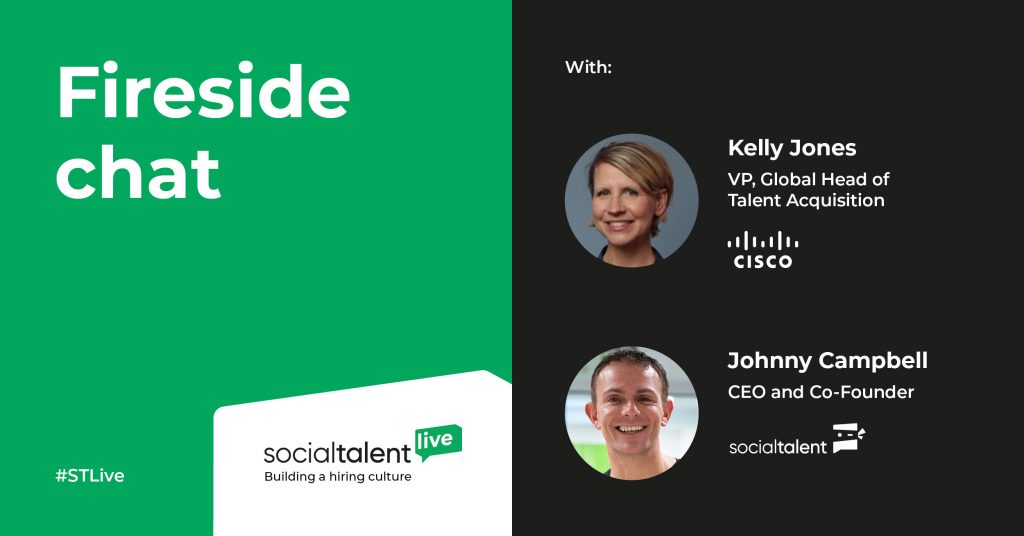
Johnny Campbell’s fireside chat with Kelly Jones shed light on a global organization currently in the midst of their journey to create a hiring culture. When asked to define the concept, Kelly likened a thriving hiring culture to the fanatical fondness that those involved with CrossFit speak about their sport – it’s all encompassing! But it’s a priority for Cisco. Kelly explained that they spend a lot of time listening to their employees, and understanding from them what should be the crucial elements of their people strategy. Hiring invariably tops the response.
When asked about the relation between hiring cultures and internal mobility, Kelly stated that while talent mobility has to form an integral part of how leaders foster a culture of hiring, there are often challenges when marrying both external and internal approaches. The problem often lies in tools. For example, when it’s easier to find talent on LinkedIn compared to within your own company, it stifles a leader’s ability to be able to identify, develop and move talent. To create a true ecosystem of hiring, leaders have to be encouraged not to hoard people, but see employees more holistically as part of the wider organization.
In terms of measuring success, Kelly pointed to the importance of data. In Cisco, they track different variables, like candidate experience, referral numbers and response time to give a complete picture on how their hiring culture is flourishing. It’s critical for this to be a metric for leaders within the company. Nothing really changes until that is in place. Additionally, by investing in SocialTalent’s training, they are able to continually upskill leaders and Hiring Managers to not only hire better, but understand the importance of it for the company. Finally, to underscore her argument for a hiring culture, Kelly ended with this pearl:
“If you don’t have time to focus on hiring exceptional talent, when are you going to find the time to performance manage that talent? Or rehire that talent a second time?”
Operationalizing a hiring culture
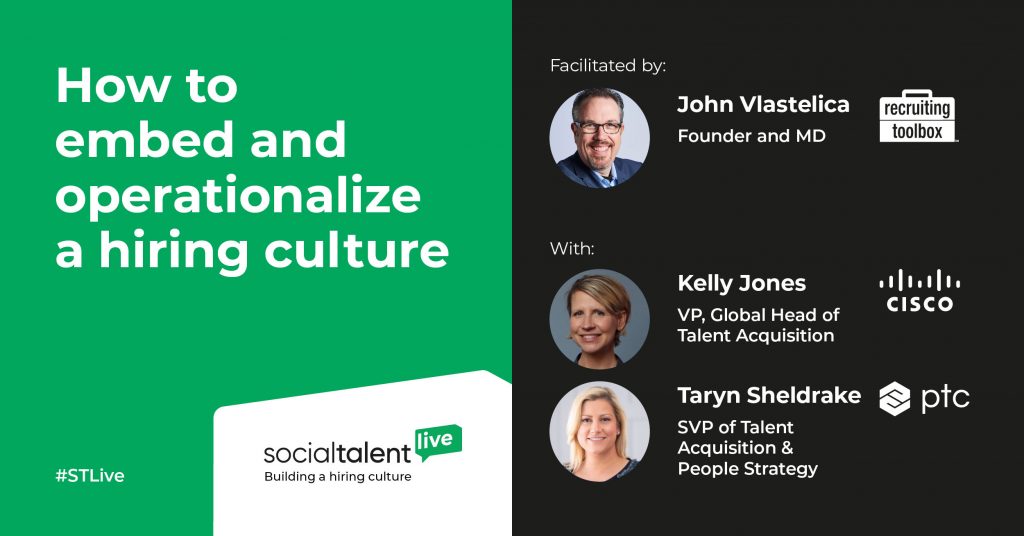
Facilitated by John Vlastelica, this final panel looked at the ‘why’ behind implementing a hiring culture. Taryn got the ball rolling by talking about the importance of leadership buy-in. In her words, you have to “get them to understand what’s in it for them.” And to do this, Taryn mentioned how TA need to create a complete narrative around hiring cultures, using data, market knowledge and internal information to frame their case. She also examined it from a company DNA perspective, stating that it can be a great opportunity to show where recruiters can step up and live the core values.
Speaking specifically of Cisco, John asked if there were any pain points that prompted this push for a hiring culture. According to Kelly, the last year itself was a huge motivator. Owing to a 500% increase in volume of requisitions, it sparked leaders into action. After all, as Kelly puts it: “a recruiting problem is a company problem.” Along with some competitor research and pinning the approach to the internal people strategy (which came about very naturally), this acted as the rocket fuel to spur on a more holistic approach to hiring.
To contextualize hiring culture, John made a very important distinction about it being a partnership, and not a move to make Hiring Managers do all the work. And Kelly agreed with this, calling it more of a “help me help you” situation. She pointed out that it’s crucial to show Hiring Managers where they can be a differentiator. Kelly used the example of outreach. A message from a leader will always gain more traction with talent than from a recruiter. Advocating for a culture of hiring means educating on how this role becomes part of the everyday, rather than a simple addition of duties.
Want to catch-up on the event? Find the full recording here.
And don’t forget to join us on November 18th for our next SocialTalent Live event which will examine the topic of how to scale hiring during The Great Resignation.
Interested in discovering how SocialTalent can help you optimize your hiring and recruiting processes? Get in-touch with us today.
About SocialTalent
SocialTalent is the e-learning platform for hiring excellence. We help organizations transform their hiring strategy by empowering everyone involved in the hiring journey with the skills to find, hire, onboard and engage the best talent.
